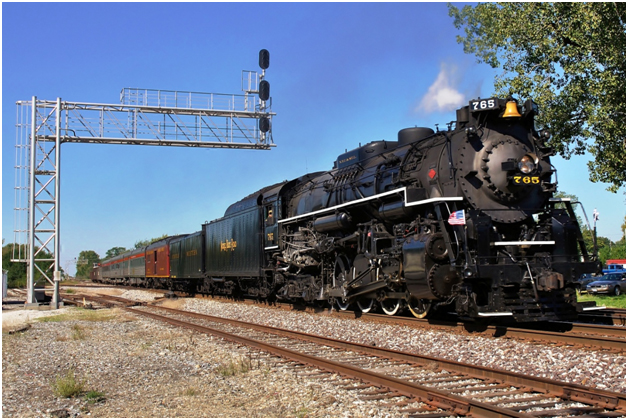
The FRA’s new regulation mandating improvements to safety related training in the rail industry applies across a wide scope of operations, including not only large and small railroads and related contractors but also to tourist rail operations running on the national system, like this preserved Nickel Plate Road steam locomotive owned by the Fort Wayne Historical Society and operating over Norfolk Southern rails at Tolono, Illinois in 2011. (©9/2011 by Paul Burgess, used with permission)
On Friday, November 7th, 2014, the United States Department of Transportation’s (USDOT) Federal Railroad Administration (FRA) issued a final rule mandating significant improvements to the way training and the documentation of training for both railroad employees and the employees of railroad industry contractors (i.e. track and infrastructure construction maintenance and other activities related to actual operations) is structured and conducted. The new rule is notable for its broad scope and application across a range of industry participants, as well as the detailed requirements it sets forth for affected parties.
In a related press release issued the same day summarizing the action, FRA noted that the new rule is designed to provide the following improvements:
- Minimum training standards for each type of safety-related railroad employee;
- FRA review and approval of each employer’s training program to ensure employees will be qualified to measurable standards;
- Greater use of structured on-the-job and interactive training;
- Methods for each employer to review and improve training programs annually with a focus on closing performance gaps; and
- A streamlined, nation-wide approach that bolsters training for operators of roadway maintenance machines equipped with a crane that work across multiple jurisdictions.
FRA is taking this action under the Rail Safety Improvement Act of 2008 (RSIA 2008). FRA further noted that under the RSIA 2008 it is also taking further action to reduce risks associated with the transport of flammable liquids, especially crude and refined petroleum oils, as well as to address train crew fatigue issues and continuing to develop standards addressing the nascent high-speed passenger rail movement.
The new regulations have an effective date of January 6th, 2015. Meeting this compliance date should prove relatively straightforward for the large Class I and Class II (i.e. national and large regional) railroads, each of whom have large internal organizations dedicated solely to safety and training; large national industry contractors such as Hulcher, Sperry, and R.J. Corman also typically include such resources on their staffs. The regulation may produce somewhat more angst on the level of Class III (i.e. “short line”) railroads and smaller industry contractors, where personnel resources tend to be spread more thinly and where often employees may “wear several hats” in terms of their daily focus and range of activities. The rule does include potential waiver eligibilities and extended deadline dates for compliance with certain provisions, depending on how an affected party’s operations are structured and sized; so, a careful reading of the scope and applicability of the rule is desirable. In an interesting and in some ways unprecedented broadening of applicability, the rule also includes tourist railroads within its scope. This is dependent on their range and type of operations and the location of such operations on or off the common national system. Given their typical reliance on volunteer employees and the often very limited range of expertise available to such organizations the regulation may produce effects in this industry segment out of proportion to its impact elsewhere.
Here is a link to the FRA press release: http://www.fra.dot.gov/eLib/details/L16037#p1_z5_gD
Here is a link to the Final Rule itself: http://www.gpo.gov/fdsys/pkg/FR-2014-11-07/pdf/2014-26290.pdf
Labelmaster is a full service provider of goods and services for the Hazardous Materials and Dangerous Goods professional, shippers, transport operators, and EH&S providers. See our full line of solutions at www.labelmaster.com.



This article proves that employee training is important in each and every field of profession. Well-trained employees can only show great productivity and indirectly caused for growth of organization.
It was very nice to read that there is improvement in employee training and indirectly it will definitely affect on organizational growth and customer satisfaction.